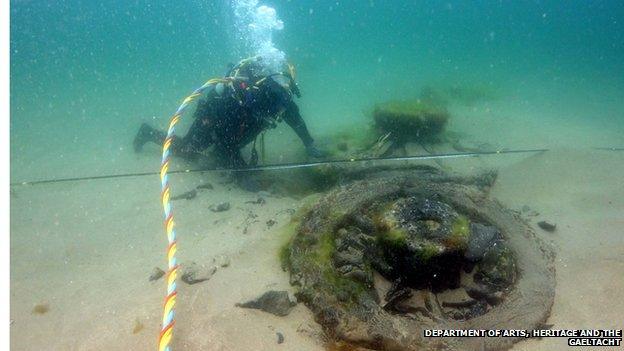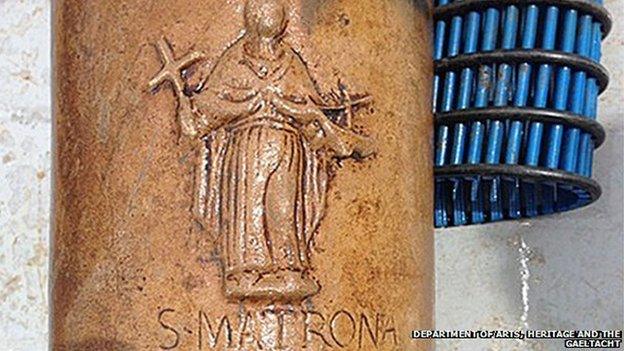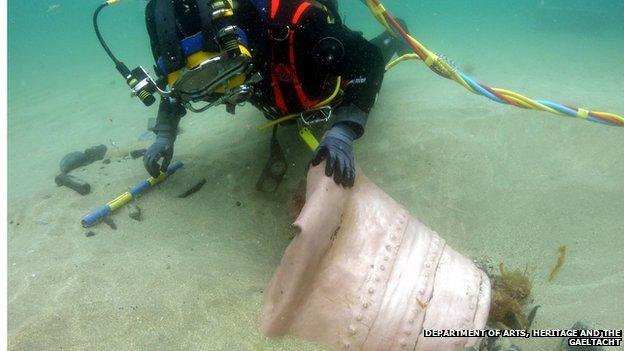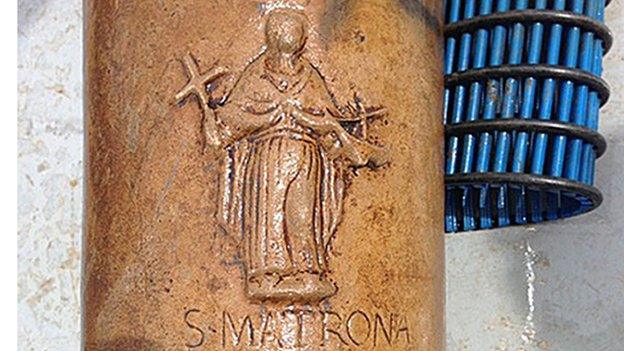Spanish Armada cannon recovered from sea off Sligo
- Published

A gun carriage wheel from La Juliana was found on the seabed
The first of six bronze cannon from the Spanish Armada fleet has been raised from the sea off County Sligo.
The artefacts are from La Juliana - one of three galleons shipwrecked off the Irish coast at Streedagh in 1588.
Severe winter storms over the past two years uncovered the treasure from the seabed.
Six bronze cannon, a gun carriage wheel, cannon balls and a ship's cauldron have been recovered.
Senior archaeologist Finbar Moore told BBC NI's Good Morning Ulster that the cannon were "in beautiful condition".
"The Juliana was a Catalan ship, built near Barcelona. It features a lot of the Catalonian traditions of ship building," he said.

One gun bears this inscription to St Matrona
"It was built as a trading and merchant ship, but it was commandeered on four occasions by King Philip II of Spain for various campaigns."
Mr Moore said a team from Ireland's National Monument Service inspected the site in April after timber started washing up on the shoreline.
The treasure they found made the site a priority.
"We were surprised to find a number of guns exposed. The structure remains at stern end.
"We found bronze cannon in beautiful condition that had never been seen before. They are both beautiful and ornate," he said.
"They feature saints like St Matrona - who was venerated very much in that part of Spain and St John," he said.
One of the cannon depicts a bearded St Peter wielding the keys to heaven.

A diver brings a cauldron from the shipwreck out of the sea
All of the guns will be moved to the National Museum of Ireland.
Heather Humphreys, the Irish minister for arts, heritage and the gaeltacht, visited the wreck site in June.
"The variety of guns being recovered graphically illustrates the history of the ship itself, from its origins as a trading vessel when it was built in 1570 to its use as a warship during the ill-fated Spanish Armada campaign of 1588," she said.
"The entire operation, which will conclude this week, has been very successful.
"The artefacts recovered will now be conserved by the National Museum, ensuring their safe keeping for generations to come.
Two other vessels from the Armada sank nearby in violent storms in September 1588.
More than 1,000 soldiers and mariners drowned when the La Lavia and Santa Maria de Vision went down.
La Juliana traded between Spain and Italy until King Philip II commandeered it for the Armada fleet of 130 ships to invade England and take Queen Elizabeth I's throne.
The boat weighed 860 tons, carried 32 guns, 325 soldiers and had a crew of 70.
A security operation is in place to safeguard the valuable shipwreck site from treasure hunters.
According to the Irish Times, a campaign to establish a permanent Armada museum in Grange village close to Streedagh is gathering momentum.
- Published17 June 2015
